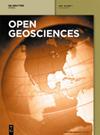Geospatial modeling of wildfire susceptibility on a national scale in Montenegro: A comparative evaluation of F-AHP and FR methodologies
IF 1.3
4区 地球科学
Q3 GEOSCIENCES, MULTIDISCIPLINARY
引用次数: 0
Abstract
Wildfires pose a significant ecological, environmental, and socioeconomic challenge in southeastern Europe. The preservation of wildlands is not only essential but also a foremost priority for Montenegro, a country recognized as the world’s first ecological state. Consequently, the development of optimal methodologies and models is of paramount importance to enhance fire protection measures. With this objective in mind, this study strives to create a wildfire susceptibility model on a national scale for Montenegro. The study employed seven natural and anthropogenic causative criteria: vegetation type; aspect; slope; elevation; climate classification; distance from road; and population. The modeling process integrates both natural and anthropogenic causal criteria, employing the Fuzzy Analytic Hierarchy Process (F-AHP) and Frequency Ratio (FR) within geoinformatics environment. The outcomes of the F-AHP model reveal that 72.84% of the total area is categorized as having high to very high susceptibility. Conversely, based on the FR model, only 29.07% of the area falls within these susceptibility levels. In terms of validation, the area under curvature values indicates good performance of the F-AHP model. In contrast, the FR model demonstrates poor performance. These novel findings, pertaining to Montenegro at a national scale, offer valuable insights for preemptive wildfire safeguarding efforts. Moreover, the methodologies employed, with necessary modifications, hold potential for application in geographically diverse regions.黑山全国范围内野火易发性的地理空间建模:F-AHP 和 FR 方法的比较评估
野火对东南欧的生态、环境和社会经济构成了重大挑战。黑山被公认为世界上第一个生态国家,保护荒地不仅至关重要,而且是黑山的首要任务。因此,开发最佳方法和模型对于加强防火措施至关重要。考虑到这一目标,本研究致力于为黑山创建一个全国范围的野火易感性模型。该研究采用了七种自然和人为致因标准:植被类型、地势高低、坡度、海拔高度、气候分类、与道路的距离和人口。建模过程综合了自然和人为因果标准,在地理信息环境中采用了模糊分析层次过程(F-AHP)和频率比(FR)。F-AHP 模型的结果显示,72.84% 的总面积被归类为高易感性和极高易感性。相反,根据 FR 模型,只有 29.07% 的区域属于这些易感等级。在验证方面,曲率下面积值表明 F-AHP 模型性能良好。相比之下,FR 模型的性能较差。这些与黑山全国范围有关的新发现为预防野火提供了宝贵的见解。此外,所采用的方法经过必要的修改后,有可能应用于不同的地理区域。
本文章由计算机程序翻译,如有差异,请以英文原文为准。
求助全文
约1分钟内获得全文
求助全文
来源期刊

Open Geosciences
GEOSCIENCES, MULTIDISCIPLINARY-
CiteScore
3.10
自引率
10.00%
发文量
63
审稿时长
15 weeks
期刊介绍:
Open Geosciences (formerly Central European Journal of Geosciences - CEJG) is an open access, peer-reviewed journal publishing original research results from all fields of Earth Sciences such as: Atmospheric Sciences, Geology, Geophysics, Geography, Oceanography and Hydrology, Glaciology, Speleology, Volcanology, Soil Science, Palaeoecology, Geotourism, Geoinformatics, Geostatistics.
 求助内容:
求助内容: 应助结果提醒方式:
应助结果提醒方式:


